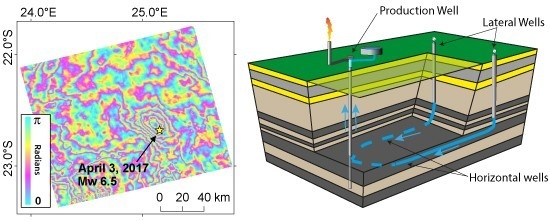Did Anthropogenic Activities Trigger the 3 April 2017 Mw 6.5 Botswana Earthquake?
Abstract
:1. Introduction
2. Materials and Methods
2.1. SAR Data
2.2. Data Modelling
3. Results
4. Discussion
5. Conclusions
Supplementary Materials
Acknowledgments
Author Contributions
Conflicts of Interest
References
- Simon, R.; Kwadiba, M.; King, J.; Moidaki, M. A history of Botswana’s seismic network. Botsw. Notes Rec. 2012, 44, 184–192. [Google Scholar] [CrossRef]
- Koothupile, B. Botswana Quake: At Least 36 Students “Affected”, Structural “Defects” Reported. Available online: http://www.news24.com/Africa/News/botswana-quake-at-least-36-students-injured-structural-defects-reported-20170404 (accessed on 3 May 2017).
- Vallée, M.; Charléty, J.; Ferreira, A.M.G.; Delouis, B.; Vergoz, J. SCARDEC: A new technique for the rapid determination of seismic moment magnitude, focal mechanism and source time functions for large earthquakes using body-wave deconvolution. Geophys. J. Int. 2011, 184, 338–358. [Google Scholar] [CrossRef]
- Kolawole, F.; Atekwana, E.A.; Malloy, S.; Stamps, D.S.; Grandin, R.; Abdelsalam, M.G.; Leseane, K.; Shemang, E.M. Aeromagnetic, gravity, and Differential Interferometric Synthetic Aperture Radar (DInSAR) analyses reveal the causative fault of the 3 April 2017 Mw 6.5 Moiyabana, Botswana Earthquake. Geophys. Res. Lett. 2017, 44, 8837–8846. [Google Scholar] [CrossRef]
- Giardini, D.; Grünthal, G.; Shedlock, K.M.; Zhang, P. The GSHAP Global Seismic Hazard Map. In International Handbook of Earthquake & Engineering Seismology; Lee, W., Kanamori, H., Jennings, P., Kisslinger, C., Eds.; Academic Press: Amsterdam, The Netherlands, 2003; pp. 1233–1239. [Google Scholar]
- Reeves, C.V. Rifting in the Kalahari? Nature 1972, 237, 95–96. [Google Scholar] [CrossRef]
- Tuttle, M.P. The earthquake potential of the New Madrid seismic zone. Bull. Seismol. Soc. Am. 2002, 92, 2080–2089. [Google Scholar] [CrossRef]
- Bakun, W.H.; Hopper, M.G. Magnitudes and locations of the 1811–1812 New Madrid, Missouri, and the 1886 Charleston, South Carolina, earthquakes. Bull. Seismol. Soc. Am. 2004, 94, 64–75. [Google Scholar] [CrossRef]
- Saito, K.; Spence, R.J.S.; Going, C.; Markus, M. Using high-resolution satellite images for post-earthquake building damage assessment: A study following the 26 January 2001 Gujarat earthquake. Earthq. Spectra 2004, 20, 145–169. [Google Scholar] [CrossRef]
- Yadav, R.K.; Kundu, B.; Gahalaut, K.; Catherine, J.; Gahalaut, V.K.; Ambikapthy, A.; Naidu, M.S. Coseismic offsets due to the 11 April 2012 Indian Ocean earthquakes (Mw 8.6 and 8.2) derived from GPS measurements. Geophys. Res. Lett. 2013, 40, 3389–3393. [Google Scholar] [CrossRef]
- Bird, P. An updated digital model of plate boundaries. Geochem. Geophys. Geosyst. 2003, 4. [Google Scholar] [CrossRef]
- Leseane, K.; Atekwana, E.A.; Mickus, K.L.; Abdelsalam, M.G.; Shemang, E.M.; Atekwana, E.A. Thermal perturbations beneath the incipient Okavango Rift Zone, northwest Botswana. J. Geophys. Res. Solid Earth 2015, 120, 1210–1228. [Google Scholar] [CrossRef]
- Keranen, K.M.; Savage, H.M.; Abers, G.A.; Cochran, E.S.; Humphreys, E.; Karlstrom, K.; Ekström, G.; Carlson, C.; Dixon, T.; Gurnis, M.; et al. Potentially induced earthquakes in Oklahoma, USA: Links between wastewater injection and the 2011 Mw 5.7 earthquake sequence. Geology 2013, 41, 699–702. [Google Scholar] [CrossRef]
- Ellsworth, W.L. Injection-induced earthquakes. Science 2013, 341, 142–149. [Google Scholar] [CrossRef] [PubMed]
- Barbee, J. Did Fracking in Botswana Cause Johannesburg to Tremble? Available online: https://www.dailymaverick.co.za/article/2017-04-04-did-fracking-in-botswana-cause-johannesburg-to-tremble/#.WSWA-2jyi72 (accessed on 5 May 2017).
- Tlou Energy Ltd. Tlou Energy Limited Annual Report (2010–2016). Available online: http://tlouenergy.com/reports (accessed on 5 July 2017).
- Stramondo, S.; Trasatti, E.; Albano, M.; Moro, M.; Chini, M.; Bignami, C.; Polcari, M.; Saroli, M. Uncovering deformation processes from surface displacements. J. Geodyn. 2016, 102, 58–82. [Google Scholar] [CrossRef]
- Sharma, R.C.; Tateishi, R.; Hara, K.; Nguyen, H.T.; Gharechelou, S.; Nguyen, L.V. Earthquake Damage Visualization (EDV) technique for the rapid detection of earthquake-induced damages using SAR data. Sensors 2017, 17, 235. [Google Scholar] [CrossRef] [PubMed]
- Hu, J.; Wang, Q.; Li, Z.; Zhao, R.; Sun, Q. Investigating the ground deformation and source model of the Yangbajing geothermal field in Tibet, China with the WLS InSAR technique. Remote Sens. 2016, 8, 191. [Google Scholar] [CrossRef]
- Wegmuller, U.; Werner, C. Gamma SAR processor and interferometry software. In ERS Symposium on Space at the Service of Our Environment; ESA Publications Division: Florence, Italy, 1997; pp. 1687–1692. [Google Scholar]
- Costantini, M. A novel phase unwrapping method based on network programming. IEEE Trans. Geosci. Remote Sens. 1998, 36, 813–821. [Google Scholar] [CrossRef]
- Yu, C.; Penna, N.T.; Li, Z. Generation of real-time mode high-resolution water vapor fields from GPS observations. J. Geophys. Res. Atmos. 2017, 122, 2008–2025. [Google Scholar] [CrossRef]
- Okada, Y. Surface deformation due to shear and tensile faults in a half-space. Bull. Seismol. Soc. Am. 1985, 75, 1135–1154. [Google Scholar]
- Bagnardi, M.; Hooper, A. Bayesian inversion of surface deformation data for rapid estimate of source parameters: A proposed approach. 2017; (in prep.). [Google Scholar]
- Hastings, W.K. Monte Carlo sampling methods using Markov chains and their applications. Biometrika 1970, 57, 97–109. [Google Scholar] [CrossRef]
- Mosegaard, K.; Tarantola, A. Monte Carlo sampling of solutions to inverse problems. J. Geophys. Res. Solid Earth 1995, 100, 12431–12447. [Google Scholar] [CrossRef]
- Hopper, A.; Pietrzak, J.; Simons, W.; Cui, H.; Riva, R.; Naeije, M.; Terwisscha van Scheltinga, A.; Schrama, E.; Stelling, G.; Socquet, A. Importance of horizontal seafloor motion on tsunami height for the 2011 Mw = 9.0 Tohoku-Oki earthquake. Earth Planet. Sci. Lett. 2013, 361, 469–479. [Google Scholar] [CrossRef]
- Webster, R.; Oliver, M.A. Geostatistics for Environmental Scientists, 2nd ed.; John Wiley & Sons Inc.: Chichester, UK, 2007; ISBN 978-0-470-02858-2. [Google Scholar]
- Atzori, S.; Antonioli, A. Optimal fault resolution in geodetic inversion of coseismic data. Geophys. J. Int. 2011, 185, 529–538. [Google Scholar] [CrossRef] [Green Version]
- Chisenga, C. Understanding the Earth Structure Underneath Botswana: The Tectonic Model and Its Relationship to the Basement and Crustal Thickness. Master’s Thesis, University of Twente, Enschede, The Netherlands, 2015. [Google Scholar]
- Albano, M.; Barba, S.; Tarabusi, G.; Saroli, M.; Stramondo, S. Discriminating between natural and anthropogenic earthquakes: Insights from the Emilia Romagna (Italy) 2012 seismic sequence. Sci. Rep. 2017, 7, 282. [Google Scholar] [CrossRef] [PubMed]
- Davies, R.; Foulger, G.; Bindley, A.; Styles, P. Induced seismicity and hydraulic fracturing for the recovery of hydrocarbons. Mar. Pet. Geol. 2013, 45, 171–185. [Google Scholar] [CrossRef] [Green Version]
- McGarr, A.; Simpson, D.; Seeber, L. Case histories of induced and triggered seismicity. Int. Geophys. 2002, 81, 647–661. [Google Scholar] [CrossRef]
- Suckale, J. Moderate-to-large seismicity induced by hydrocarbon production. Lead. Edge 2010, 29, 310–319. [Google Scholar] [CrossRef]
- McGarr, A.; Bekins, B.; Burkardt, N.; Dewey, J.; Earle, P.; Ellsworth, W.; Ge, S.; Hickman, S.; Holland, A.; Majer, E.; et al. Coping with earthquakes induced by fluid injection. Science 2015, 347, 830–831. [Google Scholar] [CrossRef] [PubMed]
- Mulargia, F.; Bizzarri, A. Anthropogenic Triggering of Large Earthquakes. Sci. Rep. 2015, 4, 6100. [Google Scholar] [CrossRef] [PubMed]
- Liu, S.; Xu, L.; Talwani, P. Reservoir-induced seismicity in the Danjiangkou Reservoir: A quantitative analysis. Geophys. J. Int. 2011, 185, 514–528. [Google Scholar] [CrossRef]
- Segall, P. Earthquakes triggered by fluid extraction. Geology 1989, 17, 942–946. [Google Scholar] [CrossRef]
- Baranova, V.; Mustaqeem, A.; Bell, S. A model for induced seismicity caused by hydrocarbon production in the Western Canada sedimentary basin. Can. J. Earth Sci. 1999, 36, 47–64. [Google Scholar] [CrossRef]
- Segall, P. Stress and subsidence resulting from subsurface fluid withdrawal in the epicentral region of the 1983 Coalinga Earthquake. J. Geophys. Res. 1985, 90, 6801–6816. [Google Scholar] [CrossRef]
- Odonne, F.; Ménard, I.; Massonnat, G.J.; Rolando, J.P. Abnormal reverse faulting above a depleting reservoir. Geology 1999, 27, 111–114. [Google Scholar] [CrossRef]

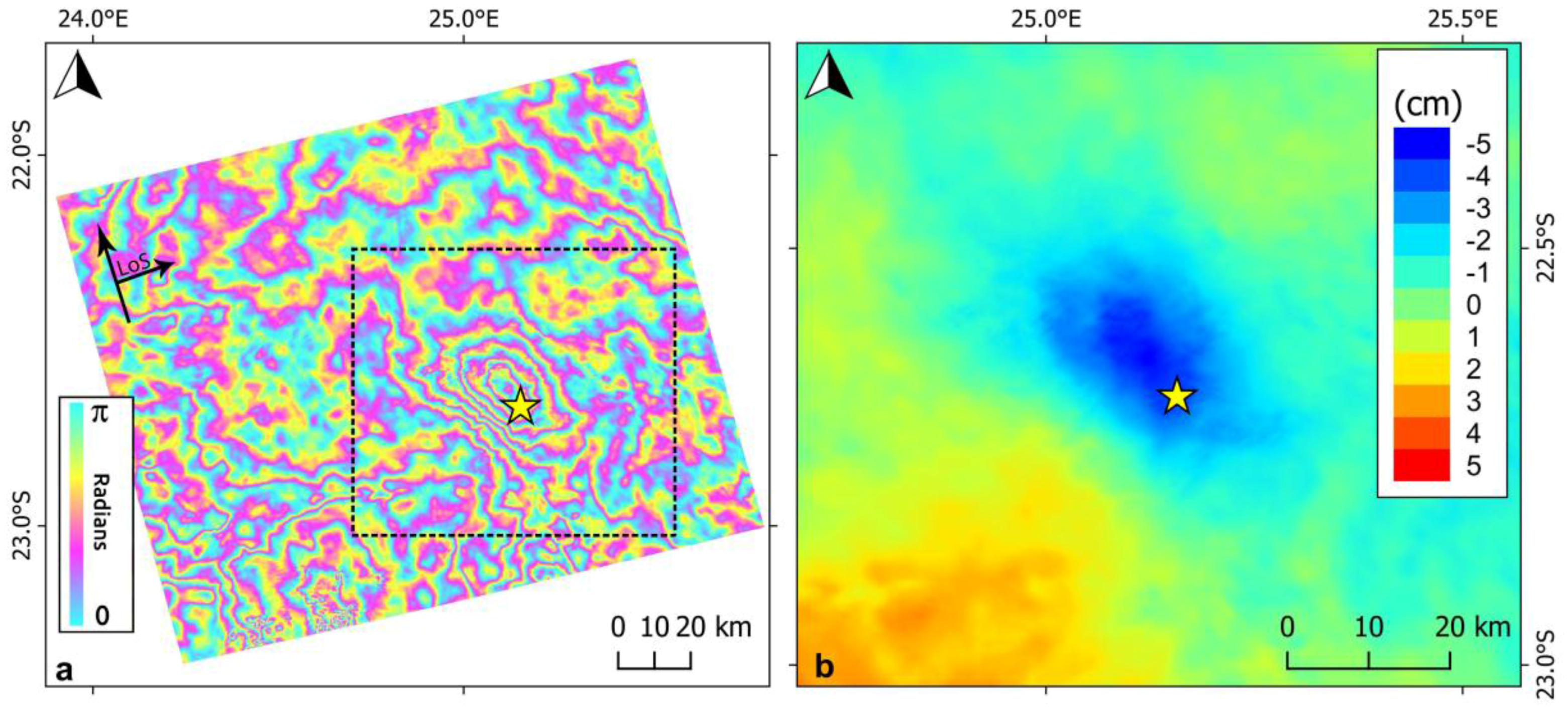
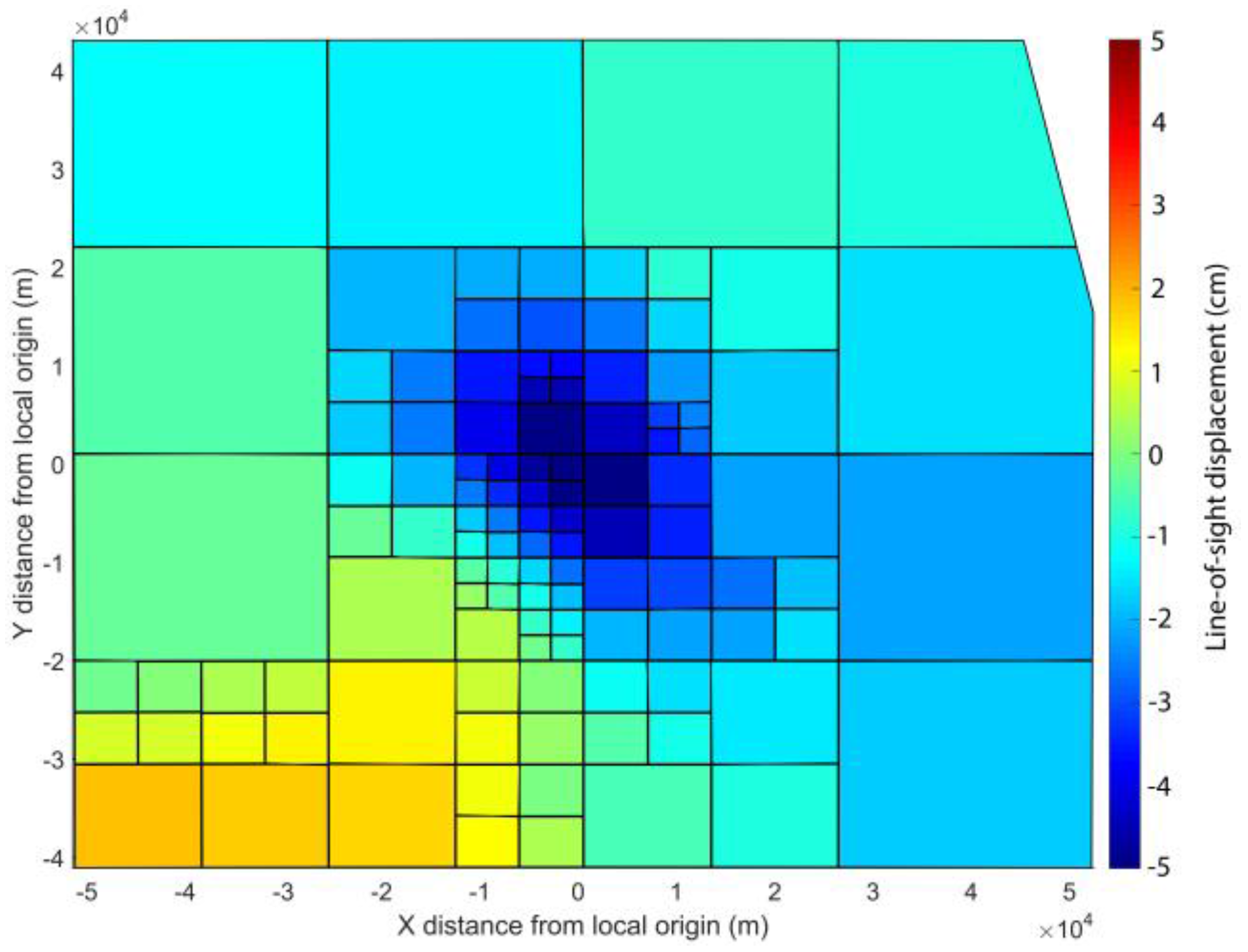
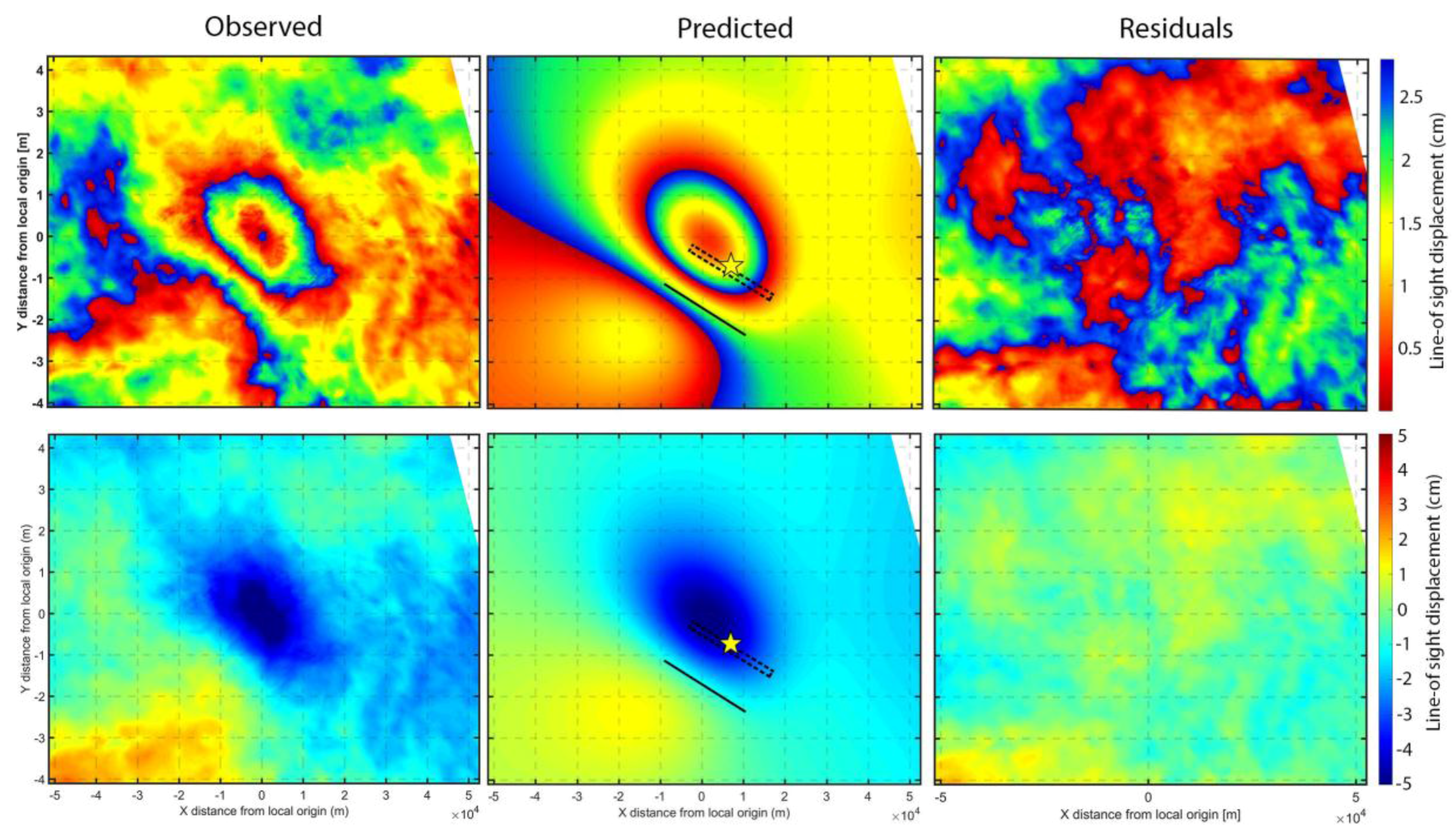
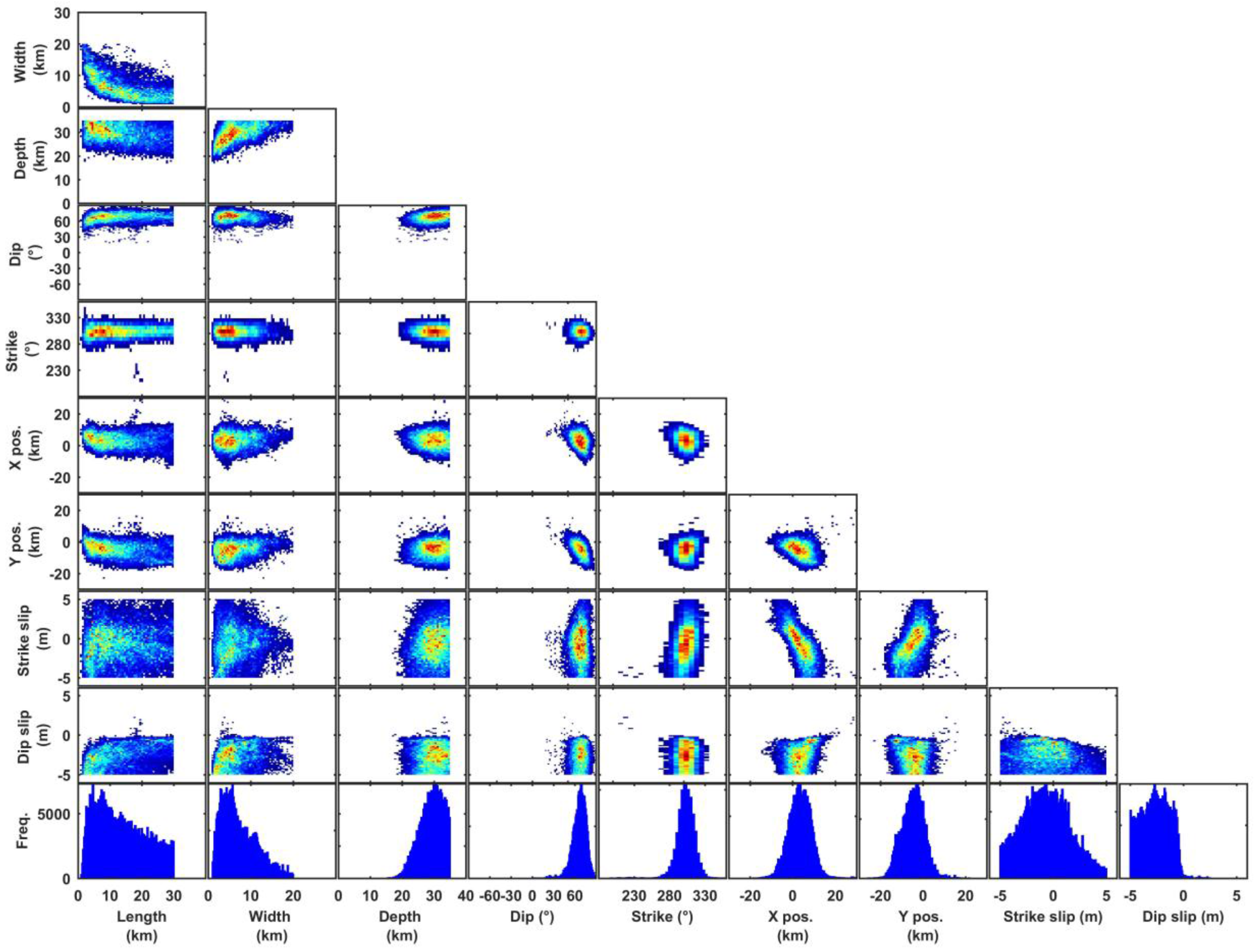
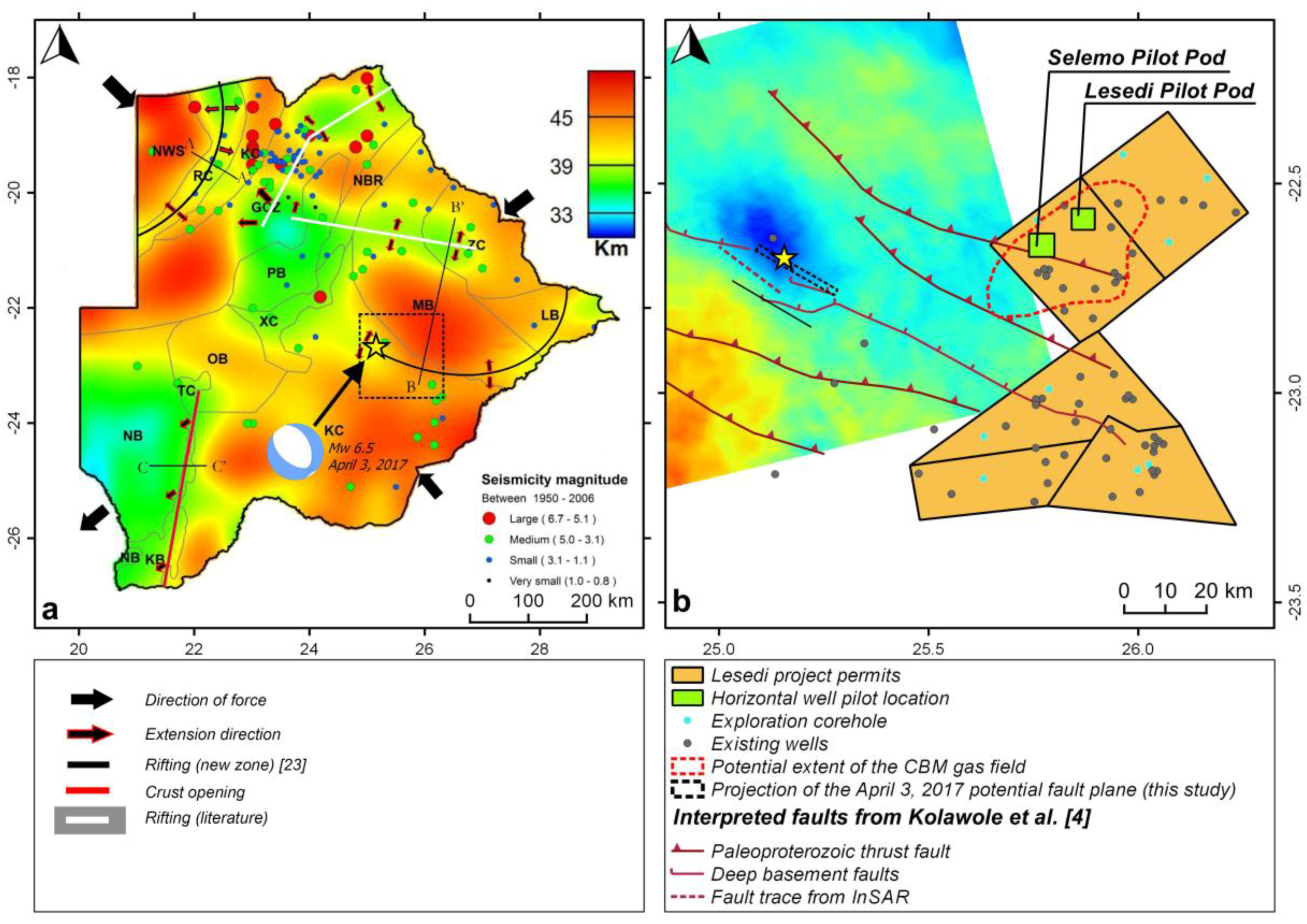

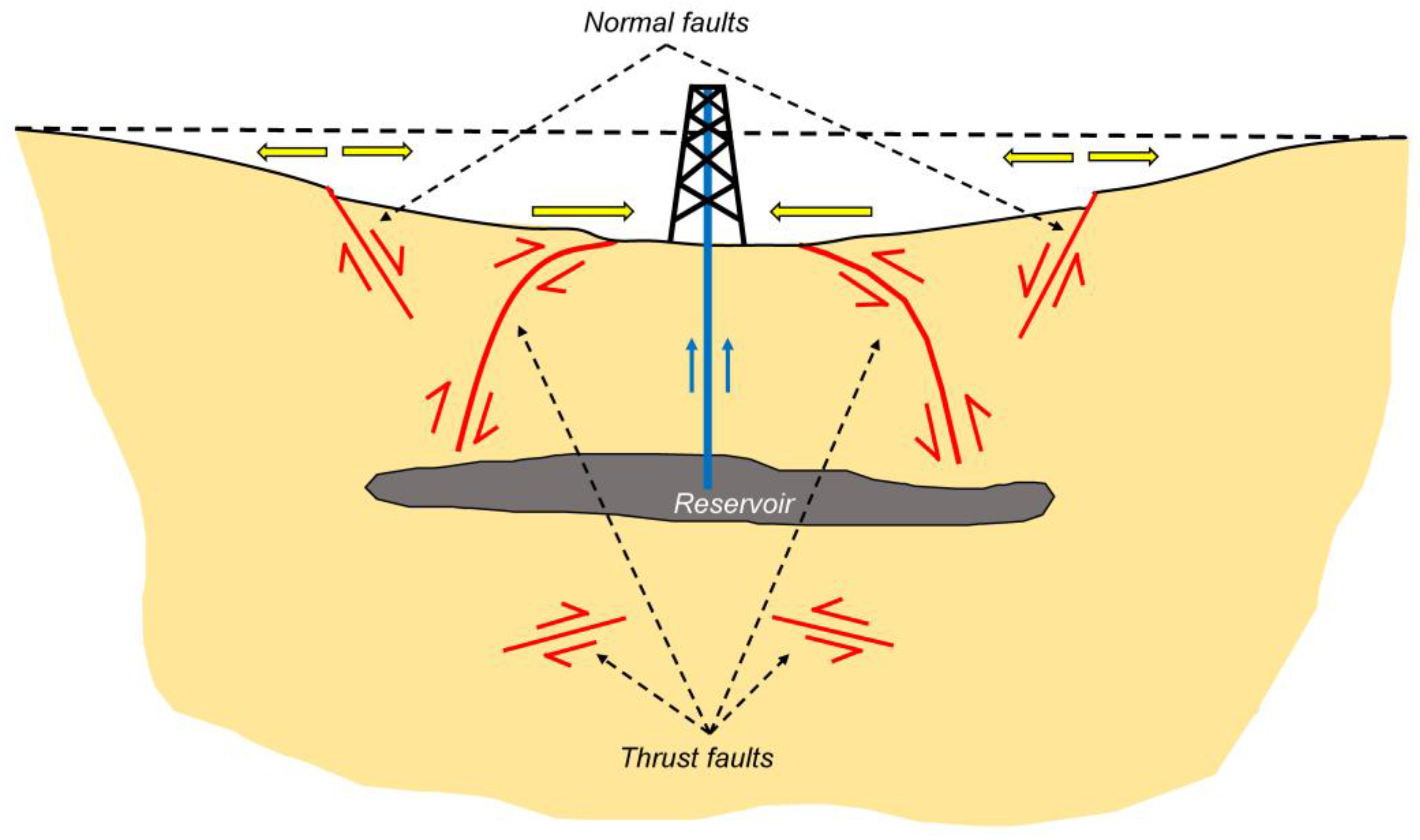
| Parameter | Length (km) | Width (km) | Depth (km) | Dip (°) | Strike (°) | X-pos. 1 (km) | Y-pos. 1 (km) | Strike slip (m) | Dip slip (m) |
|---|---|---|---|---|---|---|---|---|---|
| Start | 26 | 12 | 20 | 53 | 320 | 0 | 0 | 0.5 | 0.5 |
| Lower bound | 1 | 1 | 0.1 | −90 | 180 | −30 | −30 | −5 | −5 |
| Upper bound | 30 | 20 | 35 | 90 | 360 | 30 | 30 | 5 | 5 |
| Optimal | 21 | 3.6 | 25 | 65 | 304 | 6.4 | −8.1 | −1.97 | −1.85 |
| Parameter | Optimal | Mean | Median | 95% Confidence Interval | ||
|---|---|---|---|---|---|---|
| Length (km) | 21.1 | 13.6 | 12.5 | 2.3 | - | 28.9 |
| Width (km) | 3.6 | 7.2 | 6.2 | 1.6 | - | 17.1 |
| Depth (km) | 25.2 | 29.1 | 29.5 | 21.4 | - | 34.6 |
| Dip (°) | 65.5 | 66.4 | 67.4 | 44.6 | - | 82.2 |
| Strike (°) | 304.4 | 302.4 | 303 | 277.5 | - | 324.5 |
| X-pos. (km) | 6.4 | 3.3 | 3.4 | −7 | - | 12.9 |
| Y-pos. (km) | −8.1 | −4.7 | −4.6 | −14.7 | - | 5.5 |
| Strike slip (m) | −1.97 | −0.65 | −0.71 | −4.6 | - | 3.9 |
| Dip slip (m) | −1.85 | −2.62 | −2.6 | −4.87 | - | −0.45 |
© 2017 by the authors. Licensee MDPI, Basel, Switzerland. This article is an open access article distributed under the terms and conditions of the Creative Commons Attribution (CC BY) license (http://creativecommons.org/licenses/by/4.0/).
Share and Cite
Albano, M.; Polcari, M.; Bignami, C.; Moro, M.; Saroli, M.; Stramondo, S. Did Anthropogenic Activities Trigger the 3 April 2017 Mw 6.5 Botswana Earthquake? Remote Sens. 2017, 9, 1028. https://doi.org/10.3390/rs9101028
Albano M, Polcari M, Bignami C, Moro M, Saroli M, Stramondo S. Did Anthropogenic Activities Trigger the 3 April 2017 Mw 6.5 Botswana Earthquake? Remote Sensing. 2017; 9(10):1028. https://doi.org/10.3390/rs9101028
Chicago/Turabian StyleAlbano, Matteo, Marco Polcari, Christian Bignami, Marco Moro, Michele Saroli, and Salvatore Stramondo. 2017. "Did Anthropogenic Activities Trigger the 3 April 2017 Mw 6.5 Botswana Earthquake?" Remote Sensing 9, no. 10: 1028. https://doi.org/10.3390/rs9101028




